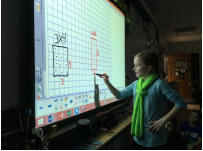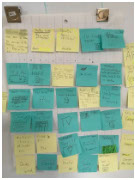Annotated lesson sequence: Grade 4
![]() (download editable lesson sequence)
(download editable lesson sequence)
![]() (download editable planning guide)
(download editable planning guide)
![]() (download support documents)
(download support documents)
Learning Experience 1 | Learning Experience 2 | Learning Experience 3 | Learning Experience 4 | Learning Experience 5
Big Ideas
- By investigating measurement problems students will extend their knowledge of measurement units and concepts, including area and perimeter.
- There are relationships between area and perimeter.
- There are different methods for calculating area and perimeter.
- There are many real world uses of area and perimeter.
Learning Goal
- We will learn to accurately determine the area and perimeter of various two dimensional shapes, especially rectangles, using an appropriate unit of measurement.
Success Criteria
- I can measure to the nearest mm with accuracy when determining the perimeter of a figure.
- I can use different strategies and tools to determine the perimeter and area of various rectangles.
- I can check the reasonableness of my answers.
- I can pose and solve problems that require the ability to distinguish perimeter and area.
- I can describe the relationship between the side lengths of a rectangle and its perimeter and area.
Overall Expectation:
Grade 4
- estimate, measure, and record length, perimeter, area, mass, capacity, volume, and elapsed time, using a variety of strategies
Specific Expectations:
Grade 4
- determine the relationships among units and measurable attributes, including the area and perimeter of rectangles.
- estimate, measure, and record length, height, and distance, using standard units (i.e., millimetre, centimetre, metre, kilometre) (e.g., a pencil that is 75 mm long)
- draw items using a ruler, given specific lengths in millimetres or centimetres (Sample problem: Use estimation to draw a line that is 115 mm long. Beside it, use a ruler to draw a line that is 115 mm long. Compare the lengths of the lines.)
- estimate, measure using a variety of tools (e.g., centimetre grid paper, geoboard) and strategies, and record the perimeter and area of polygons
- describe, through investigation, the relationship between various units of length (i.e., millimetre, centimetre, decimetre, metre, kilometre
- determine, through investigation, the relationship between the side lengths of a rectangle and its perimeter and area (Sample problem: Create a variety of rectangles on a geoboard. Record the length, width, area, and perimeter of each rectangle on a chart. Identify relationships.)
- pose and solve meaningful problems that require the ability to distinguish perimeter and area (e.g.,“I need to know about area when I cover a bulletin board with construction paper. I need to know about perimeter when I make the border.”)
- compare, using a variety of tools (e.g., geoboard, patterns blocks, dot paper), two-dimensional shapes that have the same perimeter or the same area
Topics: Perimeter/Area Review - Connections Between Area and Perimeter
Minds On: Create a Venn Diagram labeled area and perimeter. Give the students sticky notes and ask them write what they know about area and perimeter (one idea per sticky note). Have them place the statements on the Venn Diagram according to their thinking. Promote a class discussion about the placement of the ideas. (15-20 min)
Action: Simon Says-Musical Shapes Perimeter/Area Game
On large grid paper draw a variety of rectangles and cut them out. Place them on the floor around the classroom. Each student stands by a shape and waits for the teacher to call out “Simon says perimeter.” or “Simon says area.” For perimeter the student walks around the shape and for area they stand inside the shape. Every round remove one shape until you get to one student standing. (15 min.)

Consolidation: Perimeter/Area Investigation Using Geoboards: Create a variety of rectangles on a geoboard. Record the length, width, area, and perimeter of each rectangle on a chart. The teacher needs to circulate and ensure students are distinguishing between area and perimeter. (20 - 25 min)
*This is an opportunity for teachers to circulate around the class, have conversations with pairs of students and make anecdotal notes. (see Anecdotal Notes grid in the support document)
Topics: Investigating the Relationship Between Perimeter and Area
Ticket Out the Door: Briefly assess yesterday's concept with the Ticket in the Door found in the Support Document (Assessment for Learning) (5 - 10 min.)
Minds On: Project a grid onto the classroom screen or Smart Board. (see support document) Ask the students to discuss in their group how they would construct a rectangle that has a area 12 units. Have students record their answers on the projected grid. Then as a class determine the perimeter of each rectangle. (10-15 min.)
Action: Simon Says-Musical Shapes Perimeter/Area Game
On large grid paper draw a variety of rectangles and cut them out. Place them on the floor around the classroom. Each student stands by a shape and waits for the teacher to call out “Simon says perimeter.” or “Simon says area.” For perimeter the student walks around the shape and for area they stand inside the shape. Every round remove one shape until you get to one student standing. (15 min.)

Action:
Students will create rectangles with an area of 36 units 2 and record area and perimeter on the back of their sheet. (30-35 min) About 5 min. into the action, have the students stop and do a gallery walk, then return to their partner and talk about what they noticed (20 min - 30 min)(Anecdotal Observations)
Consolidation:
Have students do a gallery walk once more around the room to see how other groups have problem solved. (optional if you have extra time)
Topics: Problem Solving with Area and Perimeter
Minds On: Using a class t - chart, record students’ ideas of real-world uses of area and perimeter. E.g., laying a rug, building a fence, painting a floor etc.
Action Dog Run Problem: Pose the Problem: “Mrs. V needs to build a rectangular dog run for her dog Black Jack. She has 12 m of fencing and is trying to decide what dimensions would be best. One side of the dog run will be against the house. She is still planning this and would like students to investigate the possible configurations and make suggestions.” Students will record the area and perimeter of their dog runs.”
Ask the students to indicate which tools they need to solve the problem.

Consolidation:
Students present their work and make their recommendations as to which dog run would be best. (Looking for logic, reasoning and problem solving ability here.)
Topics: Real Life Use of Area and Perimeter
Ticket In the Door: Assess yesterday work using Task 9 (Grade 4) from An EQAO Math Support Resource for Grade 4 - 6 Teachers
This document also includes a link to an exemplar document teachers may choose to use.
Minds On: When might you care more about the area of a shape than about its perimeter? (Open Questions for the Three-Part Lesson: Measurement/Patterning and Algebra, Small, Marian, Rubicon Publishing, page 21)
Action: Mrs. Thomas’s Tidy Tiles - Problem from CEMC.UWATERLOO.CA - (Math Frog Fun Resources and Online Games)
A Copy of the problem has also been included inthe support document. (Anecdotal Observations)
Consolidation: Independent Problem Solving
Mrs. Labelle wants to put Astro Turf (fake grass) in the gym so that students may play indoor soccer. The gym measures 10 m by 8.5 m. The grass costs $9.75 per square meter. How much will it cost Mrs. Labelle to purchase the Astro Turf?
(For assessment purposes if desired.)
Topics: Assessment of Learning (this is intended to be a two day learning experience)
Ancient Home Project: This project is connected to the Grade 4 Social Studies curriculum
.
(Use the document found in the Support Documentation to introduce the project.)
It will require the student to design a home based on homes found in Ancient China where a certain space was enclosed and the various buildings, gardens and pens were located within the walls. Provided in the Support Document is the Student Outline of the project with the expectations, Student Checklist and Marking Rubric.
This is a link to a Google slide deck with photos of Ancient Chinese Compounds
As this is an assessment task there is no need for a consolidation activity however using the Ancient Chinese home as a base for the following task in Social Studies and/or Oral Language are suggestions.
- a Social studies project (mounting it on a bristol board and adding additional written information)
- oral presentation activity
(This is week one of a two week unit on Measurement.)
